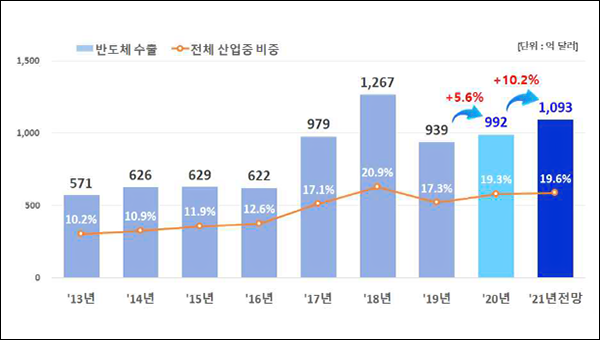반등 성공한 2020 반도체 수출, "시스템반도체, 韓 5대 수출 품목됐다"
기사입력 2021.01.06 10:55
2020년 반도체 수출 규모, 역대 2위 달성
시스템반도체, 韓 5대 수출 품목 등극
모바일·서버·PC 수요증가로 호조세 유지돼
글로벌 경기침체 상황에서 반도체 산업이 수출회복세를 주도하며 국내 경제의 버팀목 역할을 담당한 것으로 확인됐다. 이러한 추세는 올해도 지속될 전망이다.
산업통상자원부와 반도체협회는 5일, ‘'20년 반도체 시장 동향 및 '21년 전망’을 발표하며 이같이 밝혔다.

▲ 연도별 반도체 수출 추이 [그래프=산업부]
2020년 반도체 수출 규모는 992억 달러로, 2019년(939억 달러)보다 5.6% 증가하여 2018년(1,267억 달러)에 이은 역대 2위 실적을 기록했다. 반도체 수출은 7월부터 6개월 연속 증가했고, 9월부턴 4개월 연속 두 자릿수 증가율로 총수출 성장 기여도 +1.0%P를 기록했다.
거리두기 강화로 인한 야외활동 감소로 모바일향 수요가 줄어들었으나, 비대면 가속에 따른 서버와 노트북 분야 수요증가가 이를 상쇄한 것으로 나타났다. D램익스체인지에 따르면 2020년 글로벌 노트북 출하량은 1억8,663만대로, 전년 대비 14.4% 증가했다.
모바일향 수요도 5G 상용화 본격화, 중국 스마트폰 시장 경쟁 심화 등에 따라 하반기부터 회복세를 보였다. 시스템반도체는 303억 달러의 수출 규모를 기록하며 역대 최대(2018년 265억 달러)를 상회했고, 연간 기준으로 철강·석유제품을 넘어서 5위 수출 품목으로 도약했다.
◇ 올해도 반도체 시장은 성장일로
2021년 세계 경제와 교역은 5.0%, 7.2% 성장이 예상된다. 가트너, 옴디아, WSTS 등의 전망 기관은 세계 반도체 시장이 이를 뛰어넘는 보다 높은 성장률을 기록할 것으로 전망했다. 3개 사는 평균적으로 세계 반도체 시장은 8.7%, 메모리 시장은 15.5% 증가할 것으로 추산했다.
보고서에 따르면, 2021년 반도체 수출 규모는 2020년 대비 10.2% 증가한 1,075~1,110억 달러가 예상된다. 5G 시장 확대, 비대면 경제 확산 지속에 스마트폰(2.4%), 서버(6.0%), PC(5.8%) 등 전방산업 수요증가로 역대 2위의 수출실적을 1년 만에 갱신할 전망이다.
메모리는 가격상승이 예상되는 D램을 중심으로 수출이 증가하여 2020년(639억 달러) 대비 12.0% 증가한 703~729억 달러가, 시스템반도체는 5G 칩, 이미지센서 등의 수요증가와 파운드리 대형고객 확보로 2020년(303억 달러) 대비 7.0% 증가한 318~330억 달러가 전망된다.
세계 반도체 분야 설비투자는 반도체 시황 개선 기대에 따라 2019년 감소 이후 지속해서 증가세가 유지되어 2021년은 2020년보다 약 4% 증가한 720억 달러를 기록할 전망이다. 우리나라는 2019년에 중국과 대만에 빼앗긴 설비투자 1위 자리를 2년 만에 탈환할 것으로 보인다.
향후 시장에 대한 전망이 자본시장에 반영되어 2020년 12월 말 종가 기준 삼성전자 시가총액이 5,001억 달러로, 대만 TSMC(4,881억 달러)를 제치고 5개월 만에 글로벌 반도체 시가총액 1위에 재등극했다. SK하이닉스는 세계 반도체 매출(파운드리 제외) 세계 3위를 기록했다.
성윤모 산업부 장관은 “올해도 메모리 초격차 유지, 시스템반도체 자생적 생태계 조성 등을 통해 종합 반도체 강국으로 도약할 수 있도록 정책적 노력을 아끼지 않겠다”라고 밝혔다.
이수민 기자
많이 본 뉴스
[열린보도원칙] 당 매체는 독자와 취재원 등 뉴스이용자의 권리 보장을 위해 반론이나 정정보도, 추후보도를 요청할 수 있는 창구를 열어두고 있음을 알려드립니다.
고충처리인 장은성 070-4699-5321 , news@e4ds.com




.jpg)

